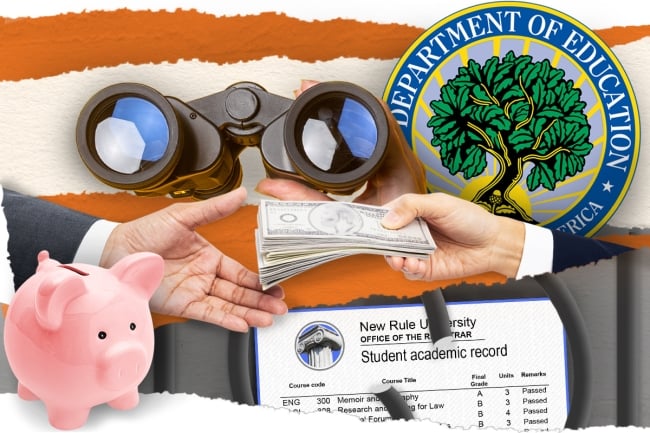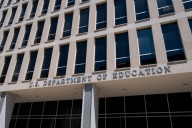You have /5 articles left.
Sign up for a free account or log in.

The changes to a range of regulations mean better protections for students and taxpayers, the Education Department said.
A federal policy change could give thousands of students access to transcripts and academic credits their colleges have withheld because they owed the institutions money. The new rule, part of a broad package of regulations the U.S. Education Department unveiled Tuesday, could amount to a national ban on the practice of transcript withholding, experts say.
Institutions sometimes withhold transcripts to force a student to pay a balance on their account. Without their transcripts, students often can’t continue their education elsewhere without starting over, and they cannot apply for certain jobs. The practice has come under increasing scrutiny in recent years, with dozens of states enacting their own bans.
The department’s new rule is broader than what the agency proposed in May and would prevent a college or university from withholding a student’s transcript for terms in which a student received federal financial aid and paid off the balance for the term. Research from Ithaka S+R, a research and consulting group, has shown that about six million students have what are called stranded credits because of transcript withholding.
“It’s a huge step forward, and it’s really going to benefit a lot of people,” said Martin Kurzweil, vice president of educational transformation at Ithaka S+R, adding that it’s essentially a national ban. “It remains to be seen how institutions interpret it and apply it. I suspect that for a lot of institutions, it’ll be more trouble than it’s worth to try to carve off a term that was completed but not fully paid for. It’ll be administratively difficult.”
The ban is part of a sweeping set of regulations finalized Tuesday that strengthens the Education Department’s oversight of institutions and gives the agency more tools and flexibility to hold all colleges accountable. Under the changes, colleges will have to agree not to withhold transcripts for course credits paid for with federal money in order for the college to access federal financial aid—one of several new conditions added to the program participation agreements institutions sign with the government.
“This change will ensure that students receive credit for the education that they have completed and help them with transfer and finding a job,” Education under secretary James Kvaal said Tuesday on a call with reporters.
Other advocates praised the department’s rule change on transcript withholding, though they are still sorting through the regulatory text to determine the exact impact.
“For a large number of students and former students who are impacted by transcript withholding, this should solve a significant portion of the problem,” said Edward Conroy, a policy fellow at New America, a left-leaning think tank. “Because in most cases, even when former students owe larger debts, nobody owes a debt for the entirety of their degree. It might be for their last semester or something like that.”
Kurzweil said the department’s decision to act on transcript withholding is “stunning,” given that Ithaka S+R wrote its first paper about the issue of stranded credits only three years ago. That paper helped to put the issue on the national radar.
“That’s lightning speed in policy terms,” he said. “It speaks to the salience of this issue and unfairness in transcript withholding. I commend the Education Department for taking this so seriously.”
Emmanual Guillory, senior director of government relations at the American Council on Education, said the department addressed a number of the lobbying group’s concerns about the proposed rule, but it still has questions and concerns about the final rule.
On transcript withholding, Guillory said he wasn’t sure of the impact because institutions approach transcript withholding differently. He said the council’s officials will need to talk to more members to get feedback on how the change could affect them.
“We’re a bit cautious about how this new language will be implemented and what this really means for our institutions,” he said.
Over all, department officials say these new rules, which take effect July 1, 2024, will better protect students and taxpayers from colleges that close abruptly, with provisions that establish warning signs when institutions might be at risk of closure and could dissuade risky behavior.
“[President Biden] told me directly that he wants us to be equally as aggressive with debt relief and accountability,” Education Secretary Miguel Cardona said on the call with reporters. “It’s one thing to help address the issues with debt that many of our borrowers have, but it’s another thing to make sure that we’re taking steps to prevent this from happening again.”
The department is particularly concerned about sudden college closures and the negative impact those have on students who can’t complete their academic program elsewhere, as well as on taxpayers who foot the bill for student loan discharges. The department sought more than $1.6 billion in liabilities from closed institutions from 2013 to 2022 but was able to collect just $344 million, according to an Education Department news release.
“Too many students have been abandoned by shady colleges that close their doors and leave borrowers with unaffordable debt and little hope of completing their educational journeys and embarking on rewarding careers,” Cardona said in a statement.
With other changes to how the department determines whether an institution should be eligible to receive federal financial aid and is capable of administering that money, the department is adding a series of safeguards to ensure that students have sufficient information about academic programs and that institutions live up to their commitments.
Combined with the gainful-employment rule finalized last month and other steps, the department is building “the most effective system ever to oversee predatory and low-quality institutions of postsecondary education,” Kvaal said.
Aaron Lacey, a lawyer who leads Thompson Coburn’s higher education practice, said that with these new rules, the department is codifying “a great deal of additional discretion” for the agency in decisions about which institutions are eligible to receive federal student aid, financial responsibility and administrative capability. With that discretion, the standards institutions would have to adhere to are unclear, he said.
That discretion could be dangerous depending on who is in charge of the department and may create uncertainty for institutions.
“We don’t know what the next administration or the administration after that may do with this greater discretion,” he said. “It’s challenging because trying to figure out how to comply with things and trying to make sure that you’re not running afoul of lines that are no longer so bright is difficult, and it can be a little frustrating.”
Clare McCann, a higher education fellow at Arnold Ventures, a philanthropy, who previously worked in the Education Department during the Obama and Biden administrations, praised the rule changes. She said the addition of more financial responsibility triggers would allow the department to move more quickly to secure some sort of financial assurance from institutions. The department can use that money from institutions to pay for student loan discharges or other liabilities.
The current triggers are “too weak to really be useful” and kick in “too late in the game,” she said. Under the new rules, colleges that are put on probation by their accreditor or that experience significant fluctuations in federal student aid volume could have to provide financial protection such as cash or a letter of credit to the government.
“This is outlining the list of events that presents a high enough risk that the department should … consider requiring financial protection,” McCann said of the triggers.
These accountability rules, she said, build on the department’s previous efforts to address the underlying causes of student debt and better protect students and taxpayers from high-risk institutions “wreaking havoc on their lives.”
“The department is enhancing its own oversight abilities, so they’re saying, ‘We have oversight of 6,000 colleges, and a number of them are risky or they’re at risk of closure. They present risks to students and taxpayers across a number of different ways, and we’re not able to use the tools in the toolbox that we have now to protect students better.’”
Guillory said ACE has more questions about how the new triggers will be used and that some of the new discretionary triggers could be troublesome.
The regulations haven’t changed much from what the department proposed in May as part of its gainful-employment rule. Thousands of comments were filed on the overall package. The department did narrow a controversial provision that would have required institutions to comply with the consumer protection laws relating to closures, recruiting and misrepresentations in all states where they enroll students if they want to receive federal financial aid. Instead, distance education providers will have to follow state laws regarding closure such as those related to teach-outs, record retention, tuition recovery funds and surety bonds. Senior department officials said that generally applicable state laws covered those misrepresentations and recruiting.
Under the new rules, the department will require institutions to meet new conditions to access federal financial aid. Institutions also will be required to provide adequate career services along with more information on financial aid offers to students, including details of the actual cost of the education being provided.
“We want to make sure that students understand the cost they are taking on when they enroll, such as the difference between a scholarship and a loan and how much they will actually have to pay themselves,” Kvaal said on the call. “Confusing information is widespread, and the Government Accountability Office has found that 91 percent of colleges do not include or understate the net price that students are expected to pay.”
Advocates have called attention to clarity and transparency in college financial offer letters for years, and lawmakers have proposed legislation that would create a standard form for all institutions to use. Most recently, hundreds of institutions pledged to improve their letters to make them easier for students and families to understand and compare.
McCann said the new requirements for financial aid offers addresses “the low-hanging fruit of what could be fixed.”
Rachel Fishman, director of the higher education program at New America, wrote in an email that the federal requirements for financial aid offers are a first for the agency.
“[It] will help create minimum standards around how institutions communicate cost and aid through their financial aid packages,” she wrote. “There is now an avenue to hold institutions accountable if their financial aid offers don’t meet these requirements. This is great news. The department has gone as far as they can with these regulations. But in order to ensure broad adherence to a standardized framework that gets students to a level where they can make apples-to-apples comparisons among offers, we need legislation like Understanding the True Cost of College.”




